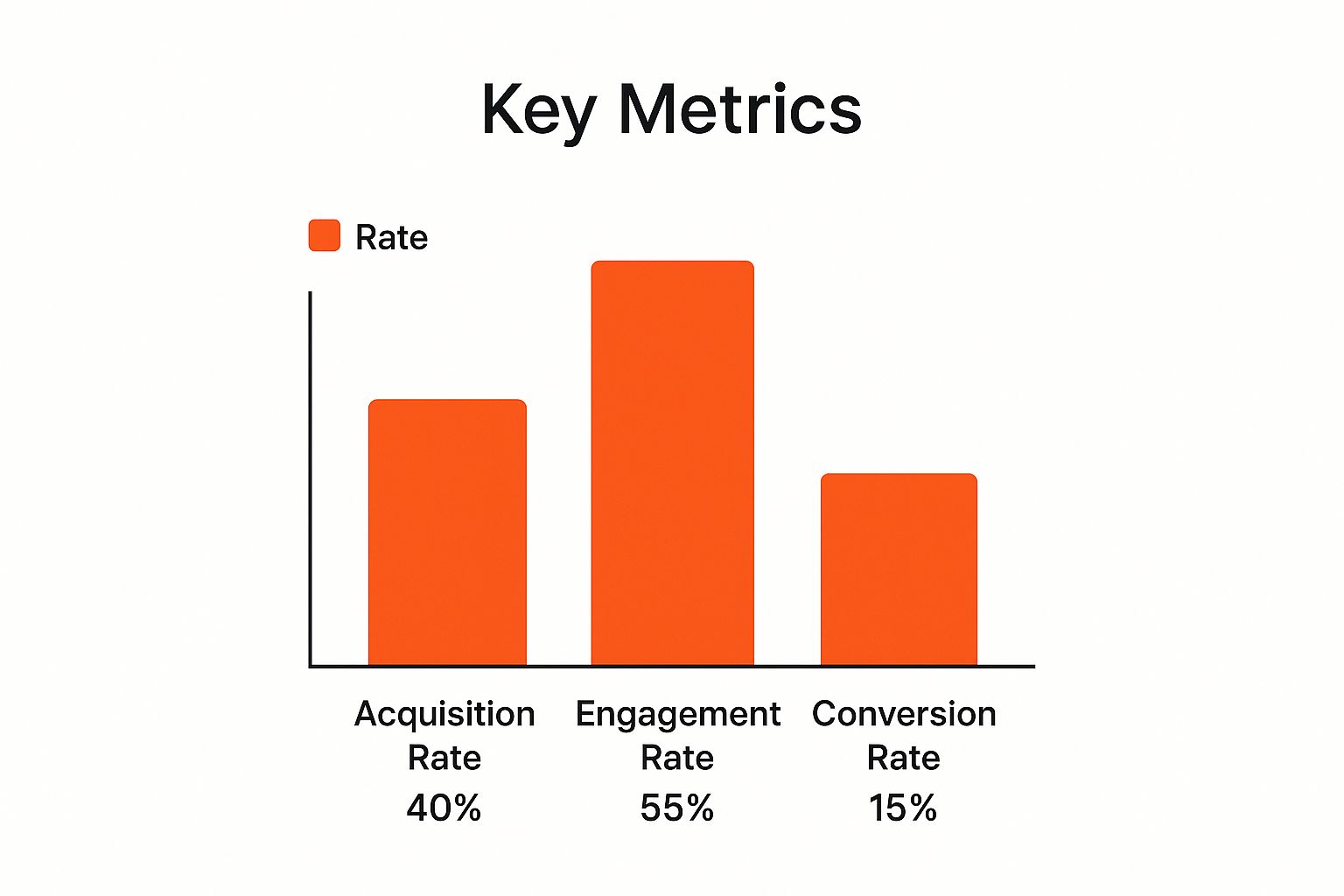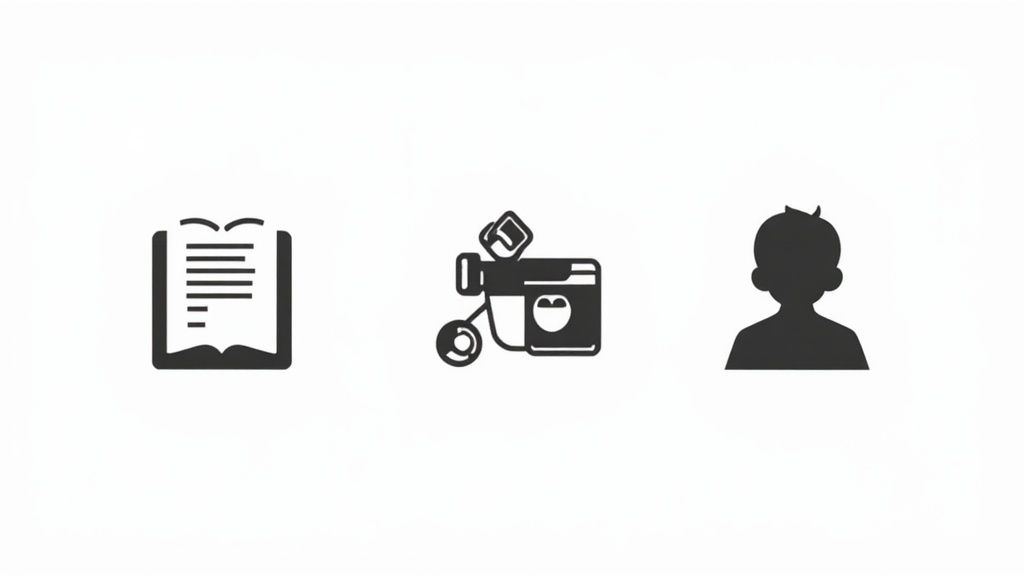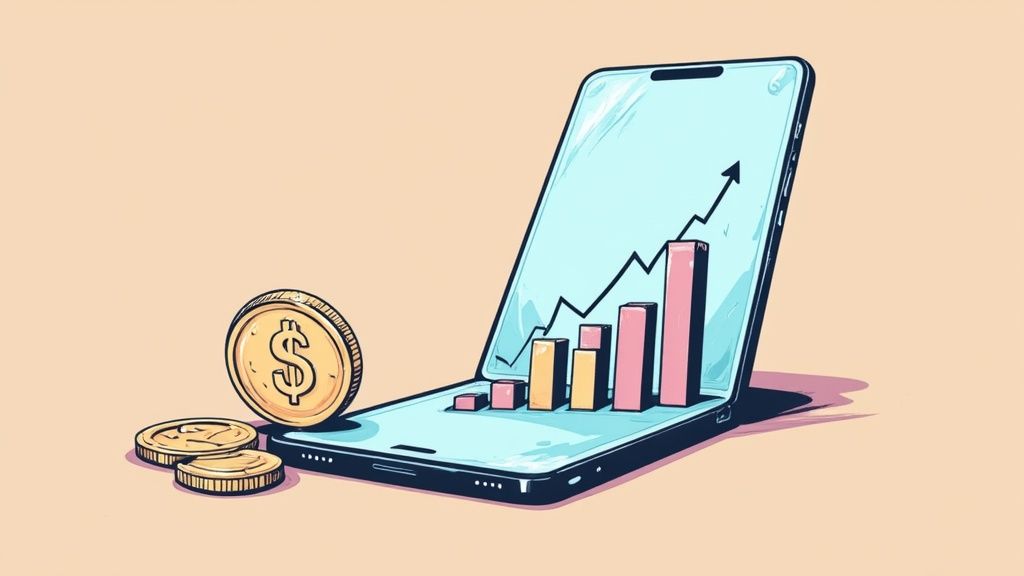Social Media Marketing for Small Business Guide
Let's be honest, social media marketing for a small business isn't just an option anymore—it's the heart of how you find new customers and build a real community. For brands today, platforms like Instagram and Facebook have become the new storefronts, where genuine connections matter more than a flashy, old-school ad ever could.
Why Social Media Is Your Business Growth Engine
It’s time to stop thinking of social media as just posting pretty pictures. It's a powerhouse for winning new customers, selling directly, and creating a loyal tribe around what you do. This isn't just another item on your long to-do list; it's a smart investment in where your business is headed.
As a small business, this is your secret weapon. You don't need a massive budget to compete with the big guys. What you have is the ability to create real, authentic relationships that larger companies can only dream of. You can skip the generic corporate-speak and have actual conversations, turning casual followers into your biggest fans.
The Shift from Broadcasting to Connecting
Remember the old days of advertising? You'd throw an ad on TV or in a magazine and just hope the right people saw it. It was a total one-way street. Social media completely flips that script. It’s a lively, two-way conversation. You get to learn straight from your customers, hear their feedback instantly, and build relationships that last. That direct line is priceless.
The data doesn't lie. A staggering 90% of small businesses are now using social media in their marketing. Even more telling is that social commerce—people buying directly through social platforms—is on track to become a $1 trillion industry by 2028. This boom shows just how much people want to connect with the brands they buy from. You can dive deeper into these social commerce trends to see exactly where things are going.
This infographic gives you a snapshot of what typical performance looks like for a small business social media campaign.

As you can see, getting people to engage is one thing. The real trick is turning that engagement into actual sales—and that's exactly what the rest of this guide is designed to help you do.
The goal isn’t just to be present; it’s to create a presence that matters. Your social media should feel less like an advertisement and more like a community hub where customers feel seen, heard, and valued.
Key Benefits for Your Small Business
So, what’s actually in it for you? A solid social media plan does a lot more than just rack up likes and follows. It delivers real results that you can see in your bottom line.
- Increased Brand Awareness: You get to meet potential customers right where they're already spending their time, making your brand a familiar face.
- Direct Customer Engagement: It's your chance to answer questions, solve problems, and get feedback on the spot. This builds incredible trust.
- Cost-Effective Advertising: Forget wasting money. You can target the exact people you want to reach, making every marketing dollar work harder.
- Boosted Website Traffic and Sales: Social media is a direct path to your products. You can guide followers from a post straight to your checkout page, turning a simple scroll into a sale.
Finding the Right Platforms for Your Audience

One of the first and most common mistakes I see small businesses make is trying to be everywhere at once. It’s a classic case of “spray and pray.” They create profiles on every platform, get overwhelmed, and end up with a bunch of half-baked accounts that don't get any real results. It’s a surefire path to burnout.
The smarter move? Go where your customers are. Think of it like fishing. You don’t just drop a line in any old pond; you go to the spot where you know your target fish are biting. Social media is no different.
Match Your Platform to Your People
Before you ever post a single picture or video, take a step back and get to know the personality of each platform. What works on one network can completely bomb on another. This is crucial, especially when you consider that over 55% of consumers say they discover new brands on social media. Picking the right channel is your first, most important step to getting found.
Let’s say you’re a local baker selling gorgeous, custom cakes. Your best bet is almost certainly a visual-heavy platform like Instagram. You can use Stories to give behind-the-scenes glimpses of your decorating process and Reels to showcase the final, stunning creations. People are on Instagram for that exact kind of visual inspiration.
Now, imagine you’re a B2B tech consultant. Those beautiful cake photos won’t do much for you. Your audience—the decision-makers and professionals—is hanging out on LinkedIn. That’s where you’ll want to share insightful articles, post detailed case studies, and join conversations about your industry to build authority and find real leads.
Your goal isn't just to find an audience; it's to find your audience. Choosing the right platform means you're not shouting into the void—you're starting a conversation in a room full of people who actually want to listen.
Platform Matchmaker for Small Businesses
To help you narrow it down, I’ve put together a quick comparison table. Think of this as your cheat sheet for finding the perfect social media home for your business. It’s not about finding the platform with the most users, but the one with the right users for you.
| Platform | Best For (Business Type) | Primary Audience | Key Content Format |
|---|---|---|---|
| Local Businesses, Retail, Community Groups, Services | Broad (Gen X & Millennials dominate) | Images, Videos, Text Updates, Events, Groups | |
| E-commerce, Fashion, Food, Beauty, Travel, Creatives | Millennials & Gen Z | High-quality Photos, Reels, Stories | |
| B2B, Tech, Consultants, Professional Services | Professionals, Decision-Makers, Job Seekers | Articles, Case Studies, Professional Updates, Text | |
| TikTok | Brands with Personality, Entertainment, E-commerce | Gen Z & Younger Millennials | Short-form, entertaining, trend-based Videos |
| Home Decor, DIY, Wedding, Food, Fashion, E-commerce | Predominantly Female, High purchase intent | Visually-appealing "Pins" (Images & Videos) |
Remember, this is a starting point. The real magic happens when you dig into the data for your specific audience. But this should give you a solid idea of where to begin your search.
Don't Try to Do It All
Focus on mastering one or two platforms first. Get really good at creating content that resonates there, build a genuine community, and understand what works. Once you have a solid foundation and a process that doesn’t drain all your time, then you can think about expanding.
This focused approach ensures your limited resources are invested where they’ll actually make an impact.
Creating a Content Strategy That Builds Community

Great social media isn't just about what you post. It's about the conversations you start and the community you build around your brand. Sure, followers are nice, but what you’re really after are loyal fans—people who feel a genuine connection and keep coming back.
This is where you shift from just broadcasting updates to crafting a content strategy with a real purpose. The trick is to think less like a marketer and more like a community manager. Your content should be a magnet, pulling your ideal customers closer and making them feel seen.
Identifying Your Core Content Pillars
Instead of waking up and wondering, "What on earth should I post today?", you need a plan. The best way to do this is by establishing three to five core content pillars. Think of these as the main themes or topics you’ll consistently talk about. They keep your message on track and your content calendar full.
Here are a few real-world examples to get the gears turning:
- Educational Tips: A local plant shop could share weekly "Plant Care 101" videos. You’re not just selling plants; you’re helping people keep them alive. That's real value.
- Behind-the-Scenes Stories: That handmade soap business? Show the messy, creative process! People love feeling connected to the craft and the person behind it.
- Customer Features: A neighborhood coffee shop can do a "Mug of the Week" featuring a regular. This celebrates your community and encourages others to share their photos (hello, user-generated content!).
- Mission-Driven Content: If sustainability is a core value, talk about your eco-friendly packaging or give a shout-out to another local green business. This attracts people who share your values.
These pillars are the bedrock of your strategy, making it so much easier to create posts that hit the mark every single time.
Developing an Authentic Brand Voice
How you say something is just as important as what you say. Your brand voice is your business’s personality, and it needs to feel authentic. Are you witty and a bit sarcastic? Or are you more of a nurturing, informative guide?
A strong brand voice doesn't just attract followers; it attracts the right followers. It acts as a filter, ensuring the community you're building is filled with people who genuinely connect with your brand's mission and personality.
Try to write your captions as if you’re talking to one person—your ideal customer. Use the words they use. Don't be afraid to throw in some emojis, ask questions, and show your human side. It’s this conversational style that sparks real engagement.
For a deeper dive into this, it's worth exploring different https://www.buildwithtoki.com/blog-post/community-marketing-strategy that put authentic conversation first.
Sparking Conversation and Building Trust
Once you have your pillars and voice down, your next job is to create content that actually gets people talking. It's not enough to just post a photo; you have to give people a reason to respond.
A caption like, "Here’s our new latte," is okay, I guess. But compare that to: "Our new lavender latte is here! Are you a fan of floral coffee flavors, or do you stick to the classics? Let us know below! 👇" See the difference? One is an announcement, the other is an invitation.
This community-first approach is more important than ever. Recent research shows that 63% of consumers want businesses to actively support local community issues. On top of that, 55% look for collaborations among small businesses. Building that local connection and sense of community can have a direct impact on your bottom line.
Finally, embrace user-generated content (UGC). When a customer tags you in a great post, reshare it to your Stories! This is gold. It’s free, authentic content and powerful social proof all in one. It shows other potential customers that real people love what you do, which is one of the most persuasive tools you have.
Running Smart Ad Campaigns on a Small Budget

Let's be honest, the idea of paid ads can feel like a big, expensive gamble for a small business. But it doesn't have to be. In reality, it's one of the most direct ways to get your business in front of the right people. While organic posts are your bread and butter for building a community, paid campaigns give you a megaphone to reach your ideal customers, right when it matters most.
Think of it as a strategic investment, not a sunk cost. Even a small budget allows you to test the waters, figure out what messaging resonates, and start generating real leads and sales. Platforms like Facebook and Instagram have made it surprisingly easy to get started, even if you only have a few dollars to spend each day.
The sheer scale of social advertising tells the story. In 2025, ad spend on social media platforms flew past $276 billion worldwide and is on track to hit over $406 billion by 2029. Most of this is happening on mobile, which makes perfect sense when you consider how much time we all spend on our phones. You can get more context on these trends from these current social media statistics and see how they shape business strategies.
Getting Started With Your First Campaign
Before you even think about putting money behind a post, you need to ask yourself one critical question: What do I actually want to achieve with this ad? Boosting a post without a clear goal is like throwing spaghetti at a wall.
Your objective could be one of several things:
- Awareness: Simply letting more people in your town know you exist.
- Engagement: Getting more likes, comments, and shares to build social proof.
- Traffic: Driving people to a specific landing page, blog post, or product on your website.
- Conversions: The big one—getting someone to buy a product or sign up for your email list.
Each of these goals requires a completely different campaign setup and will be measured with different metrics. For those of us with smaller budgets, the best bang for your buck often comes from focusing on a very specific, narrow goal, like promoting a limited-time offer or driving traffic to your most valuable piece of content.
The secret to a successful low-budget ad campaign is precision. You can't afford to target everyone, so focus your resources on the people who are most likely to become your customers.
Laser-Targeting Your Ideal Customer
This is where social media ads really flex their muscles. You can go so far beyond basic demographics like age and location. The real power is in targeting people based on what they're actually interested in, their online behaviors, and even major life events.
Let's say you run a boutique that sells eco-friendly baby clothes. Instead of targeting all "new parents," you could get incredibly specific and target:
- People who've shown an interest in "sustainable living" and "organic cotton."
- Users who have recently interacted with pages for other eco-conscious brands.
- Expecting parents who live within a 10-mile radius of your physical store.
This level of detail is a game-changer. It means your ad budget is spent talking only to the most relevant audience, which dramatically increases your chances of getting a return. It's also crucial for figuring out your costs. To get a better handle on this, it's worth learning how to use a customer acquisition cost calculator to see how better targeting directly impacts your spending.
You don't need a huge budget to start. Begin with just $5 to $10 per day and let the campaign run for at least a few days to gather data. Keep a close eye on the results, paying attention to key metrics like your Click-Through Rate (CTR) and Cost Per Click (CPC). If an ad isn't hitting the mark, don't just let it run. Pause it, tweak the image, rewrite the copy, or adjust the targeting, and then set it live again. This constant process of testing and refining is how you make every single dollar work harder for you.
Measuring What Matters for Your Business
How do you know if your social media efforts are actually working? It’s incredibly easy to get caught up in chasing followers or likes, but those "vanity metrics" don't pay the bills. For a small business, true success comes from tracking the numbers that directly contribute to your growth.
You've got to shift your focus from simply being popular online to actually being profitable. This means getting comfortable with the free analytics tools built into every social platform. Think of them as your command center for understanding what’s genuinely connecting with your audience and what's falling flat.
Moving Beyond Vanity Metrics
A post with a thousand likes feels good, but a post with 50 website clicks is infinitely more valuable for your bottom line. You need to start tracking metrics that show genuine interest and lead to real action.
Here are the key metrics you should be watching:
- Engagement Rate: This is the percentage of your audience that interacts with your content—think likes, comments, shares, and saves. A high rate tells you your content is compelling enough to make people stop scrolling and engage.
- Website Clicks (CTR): This shows how many people clicked the link in your post or bio to visit your website. It’s a direct indicator of your power to drive traffic off the social platform and into your world.
- Conversion Rate: This is the big one. It tracks how many of those website visitors actually completed a desired action, like making a purchase or signing up for your email list. This is your ultimate measure of ROI.
A classic mistake is treating all social platforms the same. Your goal on Instagram might be driving direct product sales, while on LinkedIn, it might be generating qualified leads for a service. Your metrics have to match your platform-specific goals.
Turning Data into Actionable Insights
Gathering data is just the first step. The real magic happens when you use those numbers to build a smarter strategy. This creates a powerful feedback loop: you post, you measure, you learn, and you refine your approach for next time.
Let's say your video Reels get tons of views but almost no website clicks. What does that tell you? It says your content is great at grabbing attention, but your call-to-action (CTA) is weak. The clear next step is to experiment with stronger CTAs—maybe add a clear verbal prompt in the video or use a more visible link sticker in your Stories.
Understanding which posts drive which results is also crucial. To get the full picture of how different touchpoints contribute to a sale, it’s worth learning about cross-channel marketing attribution. This helps you see the complete customer journey, not just the last click.
By constantly testing and tweaking, you transform your social media from a guessing game into a predictable and reliable engine for growing your business.
Your Top Social Media Questions, Answered
If you're running a small business, you've probably asked yourself these questions. Everyone does. Let's cut through the noise and get you some clear, practical answers so you can get back to building your brand.
"Seriously, How Often Should I Be Posting?"
Let's debunk a big myth right now: you don't need to post multiple times a day. What truly matters are quality and consistency. A chaotic posting schedule filled with flimsy content will do more harm than good.
So, where do you start? A solid baseline for most small businesses looks something like this:
- 3–5 times per week for your main feed on platforms like Instagram or Facebook.
- Daily updates for more temporary content, like Instagram Stories.
- 2–4 times per week on professional networks like LinkedIn, if that's your main hub.
Honestly, the best frequency is whatever you can realistically maintain without sacrificing quality. It’s far better to publish three genuinely engaging posts a week than to push out seven forgettable ones. Keep an eye on your analytics—they’ll tell you when your audience is online and paying attention.
"How Do I Figure Out Which Hashtags to Use?"
Think of hashtags as a roadmap helping new customers find their way to you. A smart strategy isn't about using the most popular tags; it's about using the right ones. I like to break it down into three levels.
- Broad Industry Tags: These are the big, busy highways of your industry (like
#localbusinessor#shopsmall). They offer wide exposure. - Specific Niche Tags: These are the side streets where your ideal customers hang out. Think
#handmadejewelryor#veganbakery. This is where you find highly motivated buyers. - Branded or Location Tags: This is your home address. These tags are unique to your business (
#yourbrandname) or your neighborhood (#austinboutique) and help build a loyal community.
The secret is to blend them. Use a couple of broad tags for visibility, but focus on the niche and branded tags to attract people who are genuinely looking for what you offer. Just ask yourself: what would my dream customer actually type into the search bar?
"What Are Some Free or Cheap Tools I Can Use?"
You absolutely do not need to spend a fortune on fancy software to create great content. Some of the most powerful tools out there are free or have incredibly affordable plans.
When it comes to graphics, Canva is a lifesaver. It’s packed with easy-to-use templates that make anyone look like a design pro.
For editing video on your phone, you can't go wrong with apps like CapCut or InShot. They have amazing features like auto-captions and super simple trimming tools that make creating polished video a breeze.
And for scheduling? Don't look past the Meta Business Suite. It has a free, built-in planner that lets you set up your Facebook and Instagram posts in advance. These tools give you everything you need to run a professional social media presence without breaking the bank.
Ready to turn those followers into lifelong fans? With Toki, you can build a powerful loyalty and rewards program that drives repeat sales and fosters a thriving brand community. Discover how Toki can transform your customer relationships today!